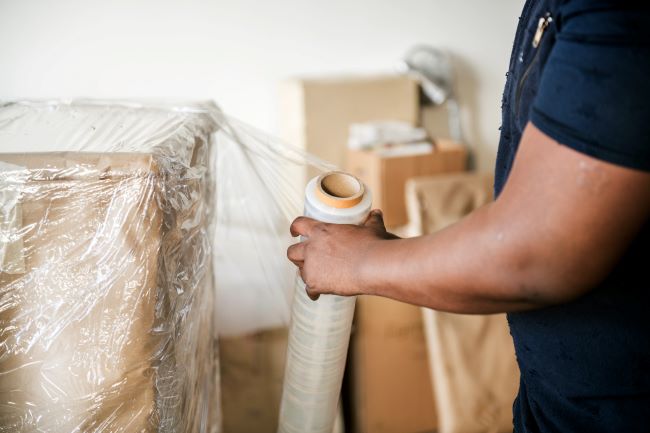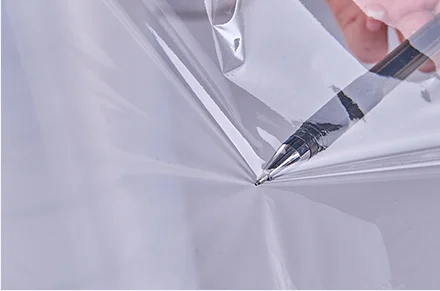Guide to Choosing the Right Stretch Film Thickness
2025-06-06
Discover how to choose the perfect stretch film thickness for your packaging needs! From guarding heavy equipment to shielding sensitive in-store products or supporting food items, this guide details the most important consideration—item type, environment, and transport needs—that will guide your choice.
What Factors Influence the Choice of Stretch Film Thickness?
The choice of stretch film thickness depends on the weight of the items, surrounding conditions, and needs for transport or storage. Picking the correct thickness ensures secure packaging. It also enhances protection and material efficiency.
The Role of Item Type and Weight
The kind and weight of the items significantly affect the choice of stretch film thickness. Heavy and large items need thicker films to stay stable during shipping. For example, industrial pallet wrapping for machinery or bulky goods often uses stronger films to avoid ripping under stress. On the other hand, light items like clothing or small retail products can use thinner films. These provide enough protection without wasting material.
Weather Conditions and Their Impact on Film Selection
Weather conditions like temperature, moisture, and sunlight exposure also matter greatly. Thicker films work better in harsh conditions, such as high moisture or changing temperatures. They resist tearing and damage more effectively. For instance, frozen goods in cold environments benefit from thicker wraps. These maintain their strength in low temperatures.
Shipping and Storage Considerations
The method of shipping and storage time also influence film choice. Long-distance transport with multiple handling stages requires a stronger film thickness. This helps withstand stress points. Similarly, items stored for long periods need durable films. These films offer higher tear resistance to keep their protective qualities over time.
How Does Stretch Film Thickness Affect Performance?
Stretch film thickness greatly impacts its performance. It balances strength, flexibility, and cost. Choosing the right thickness depends on the specific use, item characteristics, and budget.
Strength and Tear Resistance
Wider stretch films provide more strength and resistance to tearing than narrower films. They are best used for wrapping heavy items or products with sharp edges that will pierce narrower films. The material, derived from high-quality sources, is better at resisting tears and maintaining stability in transit.
Flexibility and Elasticity
Thicker films offer strength but may have less flexibility than thinner options. Thinner films often stretch more easily. This makes them suitable for oddly shaped items or loads needing tight wrapping without much force.
Cost Implications of Different Thicknesses
The cost of stretch film relates directly to its thickness. Thicker films use more materials, which raises production costs. However, their strength can reduce waste and the need for rewrapping. This can save money over time. Meanwhile, thinner films are budget-friendly. But they may need careful handling to avoid frequent replacements due to tearing.
What Are the Common Thickness Options for Stretch Films?
Stretch films come in various thickness options. Each is designed for specific uses based on item requirements and environmental factors. Knowing the benefits and limits of thin, medium, and heavy films helps in choosing the best option for securing loads effectively.
Thin Gauge Films: Benefits and Limitations
Thin films, measuring 0.018 to 0.025mm, are lightweight yet useful for safeguarding small items like food wrapping or store products. They require less material but still protect against dirt and dampness. However, their lower tear resistance limits their use for heavier or irregularly shaped items.
Medium Gauge Films: Applications and Advantages
Medium films, ranging from 0.025 to 0.035mm, offer a mix of sturdiness and adaptability. These films are commonly used in fields like shipping and technology. They are widely used in industries like logistics and electronics. These films provide moderate stability for items without sacrificing affordability.
Heavy Gauge Films: When to Use Them
Heavy gauge films ranging from 0.035 to 0.050mm are built for demanding tasks with heavy loads or abrasive environments. These strong films offer optimal puncture and tear resistance during shipping or storage over extended periods.

How to Match Stretch Film Thickness to Specific Applications?
Choosing the right thickness of the stretch film is crucial in order to achieve maximum performance on a broad spectrum of jobs, for example in industrial pallet wrapping, food and retail packaging. Sizing the film to the specific item and ambient condition provides more protection without sacrificing cost management.
Industrial Pallet Wrapping Needs
Heavy Items
For industrial uses involving heavy items like machinery parts or large appliances, heavy gauge wraps ensure maximum stability during shipping. They also protect against external impacts.
Lightweight Products
Lightweight products, such as clothing or small packaged goods, benefit from thin gauge films. These securely bundle items without adding unnecessary weight or material costs.
Food Packaging Requirements
Fresh Produce
Fresh produce needs breathable yet protective wrapping. Thin gauge wraps with high transparency allow visibility. They also prevent contamination during storage or shipping.
Frozen Goods
Frozen goods require thicker wraps. These can withstand low temperatures without losing flexibility or strength. This ensures product safety throughout the supply chain.
Retail and E-commerce Packaging
Retailers and e-commerce businesses focus on cost-effective solutions that also improve product appearance. Medium gauge wraps offer a professional look. They also maintain product security during delivery.
Why Choose Chuangyi as a Trusted Stretch Film Supplier?
Foshan Weide Chuangyi Packaging Materials Co., Ltd. is a high reputation, quality-oriented, credible stretch film manufacturer since 2004 that has excellent credibility for its innovation, customer focus, and quality. It is a customizable high-performance stretch film maker that can be produced to suit the needs of multiple industries.
Commitment to Quality and Innovation
Since 2004, Foshan Weide Chuangyi has been a top supplier of strong wrapping films. They focus on new ideas and follow a “quality first, customer first” approach. By regularly improving their tools, they meet the changing needs of businesses. Their products often go beyond what customers expect.
Wide Range of Product Offerings
Chuangyi offers a wide variety of sturdy wrapping films made from reliable materials. These come in both handmade and machine-made types. The films are tough, stick well, and resist tearing. With thicknesses from 0.018mm to 0.050mm and widths from 100mm to 1400mm, they work for both small retail items and heavy industrial uses.
Expertise in Tailored Solutions for Various Industries
Foshan Weide Chuangyi excels at creating custom solutions for fields like shipping, technology, furniture, and clothing. Their wrapping films keep goods safe during transport. They also shield delicate parts from dust and dampness.With customized sizes, thicknesses, and logo printing, the company ensures packaging exactly fits the specifications of its clients.
FAQs About Evaluating Stretch Film Thickness
Q1: What is the best thickness for heavy products?
A: For heavy-duty applications like machinery or large appliances, heavier films (0.035-0.050mm) are recommended. These films have excellent tear resistance and durability. They provide stability on transportation, even under extreme conditions.
Q2: Can thinner films be as good as thicker ones?
A: Thin films (0.018-0.025mm) are appropriate for light-weight products. They may be lacking in performance with respect to heavier films for heavy or irregularly-shaped products. The thinner films are more flexible and lower in price but not strong enough for severe applications.
Q3: Where can I get the best value stretch film for my requirements?
A: To determine a budget-friendly film, take into account the type of item, environmental requirements, and shipping requirements. Thicker films may cost more initially but reduce waste and rewrapping needs due to their strength. Thinner films are budget-friendly for lightweight or short-term uses but may need careful handling to avoid frequent replacements.

